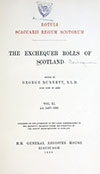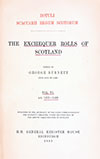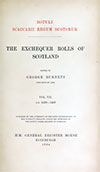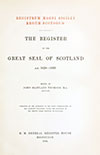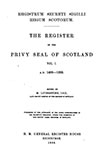

Dallyk is marked on Pont’s late 16th century map of South Strathearn as an apparent tower however Dallick House seems to be mainly 19th century in date.
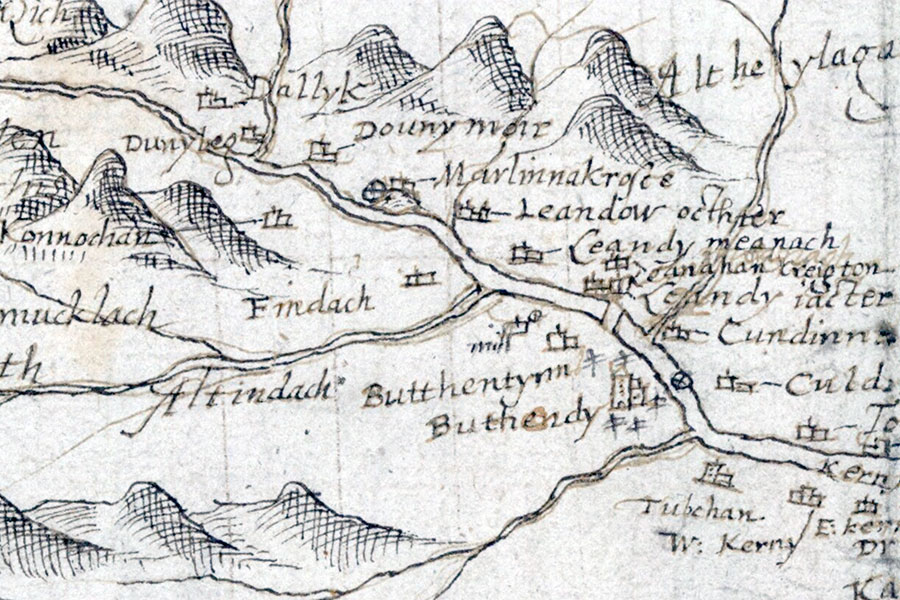
Across the River Almond from Dallick House is a mound which in 1783 was described as the remains of an old “castle”, the last stones of which were removed in that year to build a nearby bridge over the Almond. It isn’t clear if the mound definitely was a castle but it may represent the remains of a 12th or 13th century fortified site belonging to the Earls of Strathearn, known as Tom-nam-brach or Tom-na-brach, and it may represent a predecessor to Dallick House.
Dallick House occupies a site is of strategic importance, being located at the west end of lower Glenalmond where there’s a junction of sorts between the main north to south road from Crieff up through the Sma’ Glen to Aberfeldy and Dunkeld and an old route from Loch Tay in the west to Perth in the east. The house is situated on a platform high above the River Almond with commanding views to the south.
The lands of Dallick are mentioned throughout the 15th, 16th and 17th centuries in documents detailing the properties for which the Chamberlain of Strathearn was responsible. In 1456 the Chamberlain was Sir Thomas Esok, possibly Sir Thomas Isaac, and the lands of Dallek are mentioned along with hose of Westredown and Estredowne (Wester and Easter Downie), presumably now Little Dunie and Meikle Dunie.
In the earlier documents the owner or tenant of Dallick isn’t mentioned however in 1471 a Gilfulun Habrahamson, which would perhaps be anglicised or modernised as Gilfillan Abrahamson, is recorded as living at Dallyk. His son, and possibly him too, was tried in Perth and banished.
Later in the 15th century Dallik was let to Sir John Murray de Trewin, son and heir of Sir William Murray of Tullibardine. Sir John was married to Elizabeth Crichton and in 1485 received a charter of the lands of Polgour and Clow. In 1500 Dallek was recorded as being let to Elizabeth Crichton, described as the wife of the late John Murray of Pelgour. She married Sir Simon Preston of Craigmillar in 1513 but continued to rent the lands of Dallick until at least 1522, dying in 1527.
In 1542 James V granted various lands in Perthshire, including Dauleik, to William Murray of Tullibardine. These same lands were granted in 1613 by John Murray, 1st Earl of Tullibardine, and his son William, to Patrick Lyon, 1st Earl of Kinghorne, who was married to John’s daughter, Anne.
James VI granted the lands of Dallick to Patrick Murray, son of John Murray, 1st Earl of Tullibardine, in 1622, along with the lands of the Kyle of Glenalmond. These latter lands were described as being on both sides of the Almond between the lands of Henry Drummond of Balloch and Patrick Grahame, burgess of Auchterarder, and the burn of Lochtie. The grant was re-confirmed in 1624 and in 1631 Patrick Murray, granted lands in Perthshire including Dallik to his second wife Elizabeth Dent, Countess of Tullibardine.
A house is shown on the site on maps throughout the 18th and 19th centuries. Dallick remained in the Murray family as part of their Glenalmond estate until the early 19th century when the estate was broken up and sold by John Murray, 4th Duke of Atholl.
In 1805 the Duke sold Meikle and Little Downie, Miln Rodgie, Wester, Middle and Easter Lethendy and Kennochcragan to Thomas Hay Marshall, Provost of Perth, for £10,000. Two years later the Duke sold more of the Glenalmond estate, comprising the lands of Wester, Mid and Easter Fendoch, Tomnacroiche and parts of Newton and Craignafarar, to Charles Moray Stirling of Abercairny. There is no mention of Dallick in either of the transactions.
By 1857 Dallick was owned by a Mr Patton who in 1868 won a court case against the Very Rev Dr John Cunningham, minister of Crieff, concerning whether or not certain lands of Corriemuckloch were included in the valuation of the Earl of Tullibardine’s lands of Glenalmond in 1636. Dallick was instrumental in Lord Barcaple’s judgement as Dallick and the Kyle of Glenalmond were judged to have been a part of the Glenalmond estate without explicitly being named in a document of 1667, setting a precedent for Corriemuckloch.
The present Dallick House has evidently been extended to the west and more so to the east from a smaller building. It has the appearance of a 19th century shooting lodge and may have been built on the site of, and perhaps even incorporated part of, the earlier building.

Alternative names for Dallick House
Dalik; Dalleck; Dallek; Dallic; Dallick; Dallik; Dallyk; Dauleik; Dawlek; Dawlick; Dawlik; Dawlike; Dowallyc






